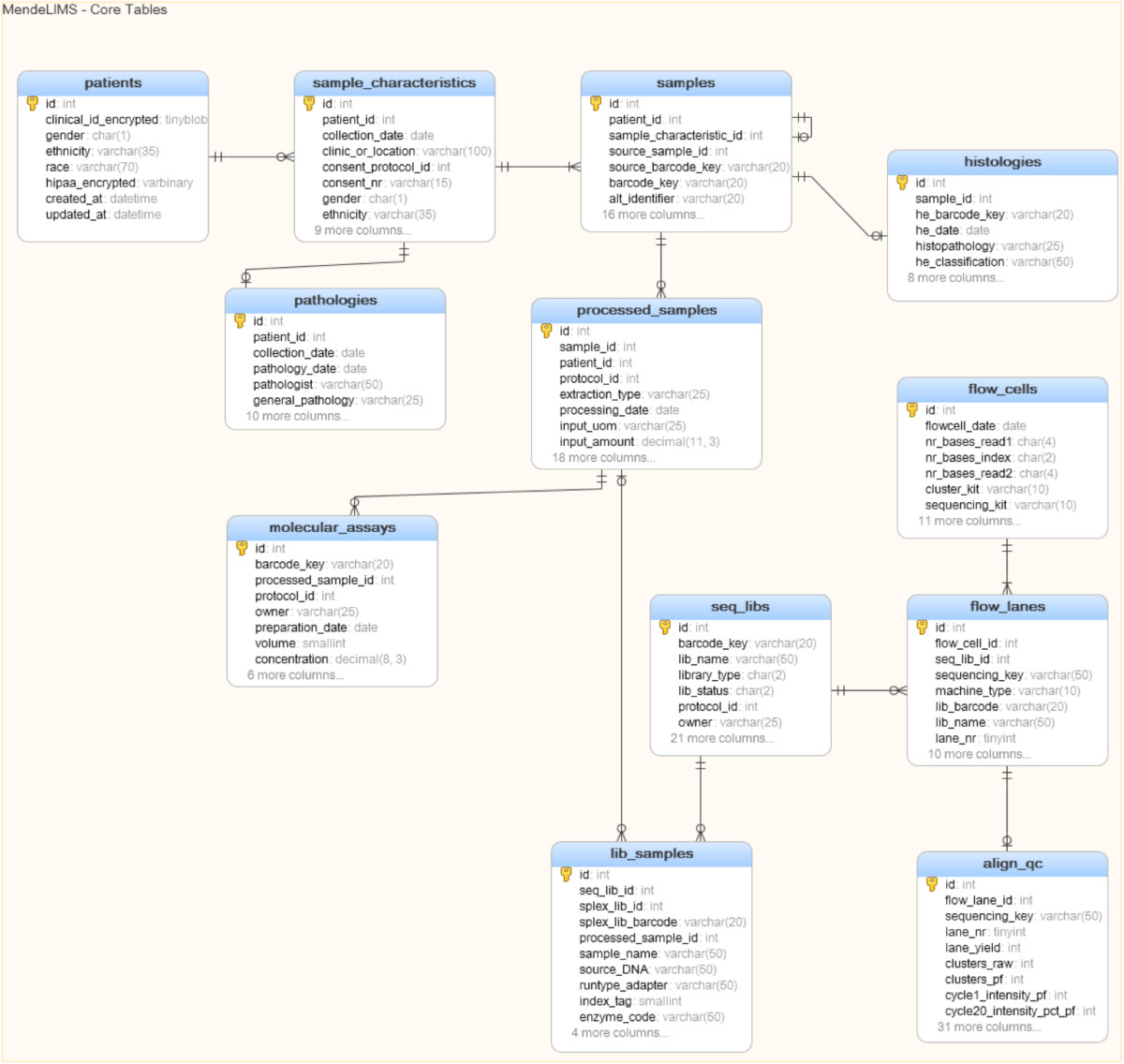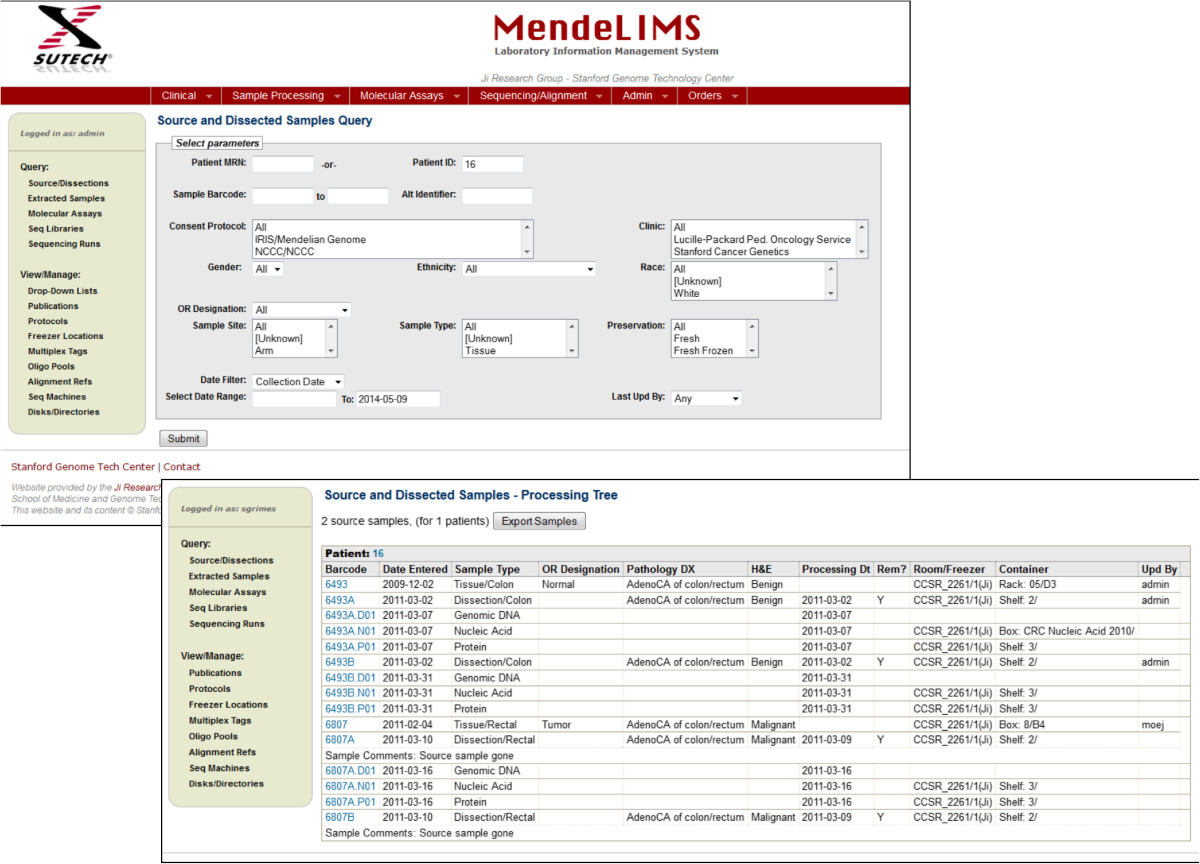Journal:MendeLIMS: A web-based laboratory information management system for clinical genome sequencing
| Full article title | MendeLIMS: A web-based laboratory information management system for clinical genome sequencing |
|---|---|
| Journal | BMC Bioinformatics |
| Author(s) | Grimes, Susan M.; Ji, Hanlee P. |
| Author affiliation(s) | Stanford University |
| Primary contact | Email: genomics_ji@stanford.edu |
| Year published | 2014 |
| Volume and issue | 15 |
| Page(s) | 290 |
| DOI | 10.1186/1471-2105-15-290 |
| ISSN | 1471-2105 |
| Distribution license | Creative Commons Attribution 2.0 Generic |
| Website | http://www.biomedcentral.com/1471-2105/15/290 |
| Download | http://www.biomedcentral.com/content/pdf/1471-2105-15-290.pdf (PDF) |
|
|
This article should not be considered complete until this message box has been removed. This is a work in progress. |
Abstract
Background: Large clinical genomics studies using next generation DNA sequencing require the ability to select and track samples from a large population of patients through many experimental steps. With the number of clinical genome sequencing studies increasing, it is critical to maintain adequate laboratory information management systems to manage the thousands of patient samples that are subject to this type of genetic analysis.
Results: To meet the needs of clinical population studies using genome sequencing, we developed a web-based laboratory information management system (LIMS) with a flexible configuration that is adaptable to continuously evolving experimental protocols of next generation DNA sequencing technologies. Our system is referred to as MendeLIMS, is easily implemented with open source tools and is also highly configurable and extensible. MendeLIMS has been invaluable in the management of our clinical genome sequencing studies.
Conclusions: We maintain a publicly available demonstration version of the application for evaluation purposes at http://mendelims.stanford.edu. MendeLIMS is programmed in Ruby on Rails (RoR) and accesses data stored in SQL-compliant relational databases. Software is freely available for non-commercial use at http://dna-discovery.stanford.edu/software/mendelims/.
Keywords: Next generation sequencing; Clinical studies; Laboratory information management; Pathology; Genomics; Genetics
Background
With next generation DNA sequencing (NGS) now being a commonly adopted technology, the genetic analysis of large clinical populations has become practical and is widely used for identifying disease-related germline and somatic variants such as cancer mutations. The genetic variation from thousands of individuals can now be identified with NGS whole genome, exome, targeted and other resequencing approaches. Due to the dramatic increase in the number of NGS clinical genomics studies, it has become increasingly important to develop adequate laboratory information managements systems (LIMS) to manage the thousands of patient samples that are subject to NGS analysis. Tracking and managing the clinical sample workflow involved in NGS analysis is an extremely difficult task, given the logistical issues of enrolling patients, fragmented procedures for acquisition of clinical study samples, complex molecular preparation steps and the intricacies of the NGS processing pipeline. Commercial systems are available but typically are high cost and require extensive modification to address the specific needs of biomedical research groups conducting genetic analysis on populations.
As a general and unique solution to the needs of managing the experimental workflow for clinical genome sequencing projects, we developed MendeLIMS, a web-based, robust and flexible solution for integrating the management of clinical study samples and NGS processes. With respect to genetic studies, MendeLIMS functionality can be grouped into four major categories: (i) enrollment of patients and acquisition of clinical study samples, (ii) sample assessment and processing, (iii) genomic analysis through preparation of next generation DNA sequencing libraries or other molecular assays such as microarrays and finally, (iv) DNA sequencing of samples with associated quality control metrics. Tracking of sequencing steps is currently supported for the following Illumina NGS instruments: GAIIx, MiSeq, HiSeq, HiSeq2500, NextSeq but can easily be configured for any type of NGS instrument which follows a sequencing library to flow cell workflow. We maintain a publicly available demonstration version of the application for evaluation purposes at http://mendelims.stanford.edu.
Implementation
MendeLIMS is written in Ruby using the open source web application framework Ruby on Rails (RoR) and implementation is platform-independent. Instructions for installation are provided in Additional file 1. For our own in-house instance of MendeLIMS, our servers run Linux/Ubuntu and we use the MySQL relational database management system (RDBMS). The application is easily configured to use any other SQL RDBMS supported by RoR. Figure 1 shows a simplified database schema for the major tables. A more comprehensive schema is provided in Additional file 2.
|
Figure 1: Database schema for MendeLIMS. Main entities and their relationships are shown in this diagram,
and a complete schema showing other ancillary tables is provided in the supplementary material.
|
The web interface is designed to handle a variety of queries in a modular format (Figure 2). To facilitate consistent data entry, MendeLIMS uses drop-down lists for seamless data validation whenever possible. The drop-down lists themselves are user-configurable by users with the appropriate authorization. Examples of user-configurable items include sample types, sequencing library multiplexing schemes, alignment references and DNA sequencers. All of the features are described in the user’s manual (Additional file 3).
Figure 2: Query web interfaces for MendeLIMS. Database queries are managed by a series of web pages that
have a modular format. Different search parameters are included with drop down menus used for standardized search
terminology. Based on the needs of any given group, the search interface can be easily modified to accommodate
new search or entry functions.
|
References
Notes
This presentation is faithful to the original, with only a few minor changes to presentation. In some cases important information was missing from the references, and that information was added.











